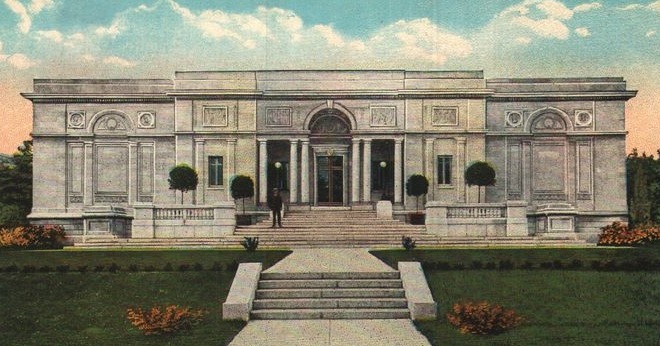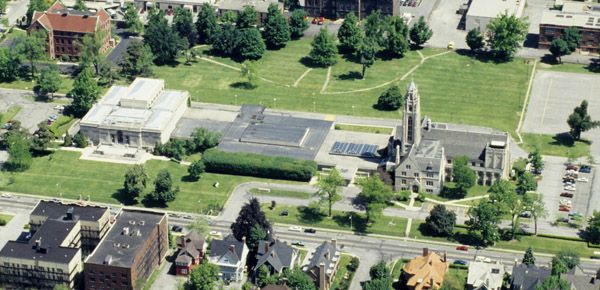
| Prince Street Campus | Memorial Art
Gallery |
 |
| 1913 Memorial Art Gallery building from old postcard |
| 1996 Aerial View of the Memorial Art Gallery |
 |
The Memorial Art Gallery was donated by Emily Sibley Watson, daughter of industrialist Hiram Sibley, in memory of her architect son, James G. Averell, with the proviso that it be maintained as “a means alike of pleasure and of education for all the citizens of Rochester.” The gallery was dedicated on October 8, 1913. The 1913 structure is the oldest one built and still owned by the University.
A new wing was added in
1926, doubling the original 14,000 square feet and adding a central
Fountain Court, children’s museum and an auditorium.
A 1968 addition again doubled the Gallery’s space and moved the entrance
to the rear.
The Vanden Brul pavilion was opened in May 1987 and linked the Gallery and Cutler Union, which housed MAG’s administrative offices and a restaurant.
References
1904 James
G Averell (1877-1904) grave in Mt. Hope Cemetery
1913 Membership brochure, Memorial Art Gallery of the University of Rochester
1927 Rochester,
the making of a university, by Jesse Leonard Rosenberger, with
an introduction by President Rush Rhees.
Page 293: In April, 1912, Mrs. James Sibley Watson, of Rochester,
daughter of Hiram Sibley, donor of Sibley Hall, announced her purpose to
give to the university, as a memorial to her son, James G. Averell, a
building to be used as an art gallery for the benefit of both the
university and the city. The building was dedicated and opened in October,
1913. An extensive addition was completed in October, 1926, as the gift of
Mr. and Mrs. James Sibley Watson, Mr. Watson being a son of D. A. Watson,
a former donor to the university and partner of Hiram Sibley. The
building, constructed mainly of Indiana limestone, is of the early
Renaissance style of architecture. The administration of the Memorial Art
Gallery, as it is called, is committed to a special board of directors, in
order to attach to the gallery for its support representatives of various
art interests in the city. Vacancies occurring in that board are to be
filled by election by the executive committee of the university, on
nomination by the board of directors of the art gallery. In 1914 the
president’s commencement reception was held in the art gallery, beginning
what became a custom.
1945 Emily Sibley Watson (1855-1945) grave in Mt. Hope Cemetery
1968 "Renaissance on Prince Street: The New Memorial Art Gallery," by Margaret Bond, Rochester Review 31(1):3-9 (Fall 1968)
1977 History
of the University of Rochester, by Arthur J. May (on-line
version with footnotes)
Chapter 17, Sunshine and Shadow
On October 8, 1913, the Memorial Art Gallery on the Prince Street Campus
was dedicated with simple but impressive ceremonies. Given by Mrs. James
Sibley Watson, daughter of the donor of Sibley Library, it was an enduring
memorial to her son, James G. Averell, a talented architect, who had died
prematurely; not only was the Gallery an ornament to the Campus, it was a
showplace of the city. While the University corporation was to act as
custodian of "a people's art gallery on the grounds of a people's
University," its affairs would be handled by an independent Board of
Managers, representing the art interests of the whole community. Members
would be appointed by University trustees from individuals nominated by
the Board of Managers, and it was prescribed by Mrs. Watson that the
donor, the University, the Rochester Art Club, and Mechanics Institute
should always be represented on the Board. Expenses would be defrayed by
income from Gallery membership primarily and from admission fees
(abolished in 1920). 12
The Memorial Art Gallery represented the attainment of an objective
cherished for decades by art lovers in Rochester. Not long after the
founding of the Genesee village, short-lived galleries were opened and
paintings and sculptures were shown in hotels or the City Hall. Several
affluent Rochesterians, moreover, accumulated art collections of merit,
and in the late nineteenth century campaigns permanent gallery were
recurrently organized, though none succeeded. The spearhead of the gallery
cause was the Rochester Art Club; created in 1875, which arranged exhibits
nearly every year; competitive ambitions were quickened by the
establishment of art galleries in Buffalo and Syracuse. Mrs. Watson, "a
steadfast friend and patron" of the Art Club, made her benefaction in
1912, the year the City of Rochester celebrated its centennial. The
veteran president of the Art Club, George L. Herdle, a creative artist and
critic, was chosen director of the Gallery and at his death in 1922, his
daughter and assistant, Gertrude Herdle Moore, 1918, assumed the
directorship. Of Herdle, Rhees said that he was "the most even-minded,
unselfish and courageous type of manhood I have known. " and a resolution
by the University faculty echoed that judgment. 13
The site chosen for the Gallery, fronting on University Avenue, conformed
to the general plan for the development of the campus. Designed by John A.
Gade, nephew of Mrs. Watson and member of a New York City architectural
firm, the structure was built under the supervision of the Rochester
architect Claude Bragdon, Rhees, as usual, keeping a shrewd eye on the
construction and expenditures. A dignified limestone building, the Gallery
resembled the Malatestas chapel in Rimini, Italy, of which Averell had
been fond. On the facade, groups in bas-relief symbolized painting and
sculpture, architecture and music, and Raphael, Michelangelo, Bramante,
and Leonardo da Vinci were commemorated in medallions. For the ceiling of
the vestibule entrance, a Danish muralist, Frode Rambusch, painted
splendid fresco, and directly ahead was placed a statue of "Memory" by
William O. Partridge with a relief portrait on its base of Averell. On the
main floor there were four bays for pictures and sculpture and the
quarters of the director; an art library, small rooms for lectures and
exhibits occupied the basement.
At the dedicatory ceremonies the principal address was delivered by Robert
W. DeForest, then vice-president of the Metropolitan Art Museum in New
York, who spoke on galleries and painting in the United States. In the
evening undergraduates demonstrated their appreciation in a merry vocal
serenade of the building. While the Gallery made a specialty of transient
showings of art objects, the permanent collections were steadily enlarged,
and community patronage of the institution, nourished by annual membership
campaigns, increased year after year. From the beginning, the promotion of
appreciation and understanding of art through exhibitions, lectures, and
instruction made the Gallery the very center of the artistic life of the
Flower City and its environs.
Thanks to the generosity of the Watson family, an extension to the Gallery
in 1926 more than doubled the space; as well as increasing exhibition
areas, library quarters were enlarged, and facilities to foster the
interest of children in artistic enjoyment and creativity were
substantially widened. Forty years later, the Gallery experience further
much-needed expansion and the original structure, now over half a century
old, underwent considerable renovation.
1988 Magnum opus : the story of the Memorial Art Gallery : 1913-1988, by Elizabeth Brayer
1998 In this place : the architectural history of the Memorial Art Gallery of the University of Rochester.
2013 The Memorial Art Gallery : 100 years, by Harper Lu
© 2021 Morris A. Pierce